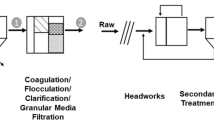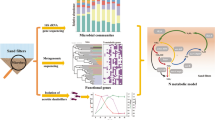Abstract
Modification of conventional rapid sand filter into granular activated carbon–sand dual media filter has become increasingly attractive to drinking water producers in many Chinese urban regions. In this study, a pilot-scale dual media filter was constructed to monitor its performance. The operational results indicated that the dual media filter performed well both on nitrification and on reduction of chemical oxygen demand. Microbial community structures at different sampling sites were also compared using 16S ribosomal ribonucleic acid gene clone library analysis to identify the spatial heterogeneity the filter. Clone library analysis illustrated the difference of microbial community structure and an increase of microbial diversity along the filter depth. Moreover, potential pathogens from genera Chromobacterium and Sphingomonas were detected in the filter samples, which deserved further serious consideration in downstream treatment such as disinfection. These findings also provided an illustration of the utility of molecular techniques to discover microbial community change and potential pathogens in the drinking water biofilters.





Similar content being viewed by others
Explore related subjects
Discover the latest articles and news from researchers in related subjects, suggested using machine learning.References
Ashelford KE, Chuzhanova NA, Fry JC, Jones AJ, Weightman AJ (2006) New screening software shows that most recent large 16S rRNA gene clone libraries contain chimeras. Appl Environ Microbiol 72:5734–5741. doi:10.1128/AEM.00556-06
Baldi M, Morales JA, Hernandez G, Jimenez M, Alfaro A, Barquero-Calvo E (2010) Chromobacterium violaceum infection in a free-ranging howler monkey in Costa Rica. J Wildlife Dis 46:306–310
Berry D, Xi C, Raskin L (2006) Microbial ecology of drinking water distribution systems. Curr Opin Biotechnol 17:297–302. doi:10.1016/j.copbio.2006.05.007
Brettar I, Höfle MG (2008) Molecular assessment of bacterial pathogens-a contribution to drinking water safety. Curr Opin Biotechnol 19:274–280. doi:10.1016/j.copbio.2008.04.004
China Environmental Protection Agency (2002) Methods for water and wastewater determination. China Environmental Science Press, Beijing
Crump BC, Kling GW, Bahr M, Hobbie JE (2003) Bacterioplankton community shifts in an Arctic lake correlate with seasonal changes in organic matter source. Appl Environ Microbiol 69:2253–2268. doi:10.1128/AEM.69.4.2253-2268.2003
Cunliffe DA (1991) Bacterial nitrification in chloraminated water supplies. Appl Environ Microbiol 57:3399–3402
De Wever A, Muylaert K, Van der Gucht K, Pirlot S, Cocquyt C, Descy JP, Plisnier PD, Vyverman W (2005) Bacterial community composition in Lake Tanganyika: vertical and horizontal heterogeneity. Appl Environ Microbiol 71:5029–5037. doi:10.1128/AEM.71.9.5029-5037.2005
Durán M, Faljoni-Alario A, Durán N (2010) Chromobacterium violaceum and its important metabolites—review. Folia Microbiol 55:535–547. doi:10.1007/s12223-010-0088-4
Emelko MB, Huck PM, Coffey BM, Smith EF (2006) Effects of media, backwash, and temperature on full-scale biological filtration. J Am Water Works Assoc 98:61–73
Griffiths RI, Thomson BC, James P, Bell T, Bailey M, Whiteley AS (2011) The bacterial biogeography of British soils. Environ Microbiol 13:1642–1654. doi:10.1111/j.1462-2920.2011.02480.x
Han XY, Han FS, Segal J (2008) Chromobacterium haemolyticum sp nov., a strongly haemolytic species. Int J Syst Evol Microbiol 58:1398–1403. doi:10.1099/ijs.0.64681-0
Huang Y, Zou L, Zhang SY, Xie SG (2011) Comparison of bacterioplankton communities in three heavily polluted streams in China. Biomed Environ Sci 24:140–145. doi:10.3967/0895-3988.2011.02.008
Kim J, Kang B (2008) DBPs removal in GAC filter-adsorber. Water Res 42:145–152
Kwon S, Moon E, Kim TS, Hong S, Park HD (2011) Pyrosequencing demonstrated complex microbial communities in a membrane filtration system for a drinking water treatment plant. Microbes Environ 26:149–155. doi:10.1264/jsme2.ME10205
Li X, Upadhyaya G, Yuen W, Brown J, Morgenroth E, Raskin L (2010) Changes in the structure and function of microbial communities in drinking water treatment bioreactors upon addition of phosphorus. Appl Environ Microbiol 76:7473–7481. doi:10.1128/AEM.01232-10
Lindstrom ES (2000) Bacterioplankton community composition in five lakes differing in trophic status and humic content. Microbial Ecol 40:104–113
Magic-Knezev A, Wullings B, Van der Kooij D (2009) Polaromonas and Hydrogenophaga species are the predominant bacteria cultured from granular activated carbon filters in water treatment. J Appl Microbiol 107:944–953. doi:10.1111/j.1365-2672.2009.04337.x
Moll DM, Summers RS, Breen A (1998) Microbial characterization of biological filters used for drinking water treatment. Appl Environ Microbiol 64:2755–2759
Niemi RM, Heiskanen I, Heine R, Rapala J (2009) Previously uncultured β-Proteobacteria dominate in biologically active granular activated carbon (BAC) filters. Water Res 43:5075–5086. doi:10.1016/j.watres.2009.08.037
Norton CD, LeChevallier MW (2000) A pilot study of bacteriological population changes through potable water treatment and distribution. Appl Environ Microbiol 66:268–276
Paerl HW, Dyble J, Moisander PH, Noble RT, Piehler MF, Pinckney JL, Steppe TF, Twomey L, Valdes LM (2003) Microbial indicators of aquatic ecosystem change: current applications to eutrophication studies. FEMS Microbiol Ecol 46:233–246. doi:10.1016/S0168-6496(03)00200-9
Schloss PD, Handelsman J (2005) Introducing DOTUR, a computer program for defining operational taxonomic units and estimating species richness. Appl Environ Microbiol 71:1501–1506. doi:10.1128/AEM.71.3.1501-1506.2005
Sudini H, Liles MR, Arias CR, Bowen KL, Huettel RN (2011) Exploring soil bacterial communities in different peanut-cropping sequences using multiple molecular approaches. Phytopathology 101:819–827. doi:10.1094/PHYTO-11-10-0310
Toh HS, Tay HT, Kuar WK, Weng TC, Tang HJ, Tan CK (2011) Risk factors associated with Sphingomonas paucimobilis infection. J Microbiol Immunol Infect 44:289–295. doi:10.1016/j.jmii.2010.08.007
Wang JZ, Summers RS, Miltner RJ (1995) Biofiltration performance: part 1 relationship to biomass. J Am Water Works Assoc 87:55–64
Wang Q, Garrity GM, Tiedje JM, Cole JR (2007) Naïve Bayesian classifier for rapid assignment of rRNA sequences into the new bacterial taxonomy. Appl Environ Microbiol 73:5261–5267. doi:10.1128/AEM.00062-07
Wiesner MR, Rook JJ, Fiessinger F (1987) Optimizing the placement of GAC filtration units. J Am Water Works Assoc 79:39–49
Yapsakli K, Mertoglu B, Cecen F (2010) Identification of nitrifiers and nitrification performance in drinking water biological activated carbon (BAC) filtration. Process Biochem 45:1543–1549. doi:10.1016/j.procbio.2010.06.004
Yu X, Zhang XJ, Wang ZS (2002) Biomass measurement in drinking water biofilters using phospholipid analytical technique. Water Wastewater Eng 28:1–6
Zhang C, Zeng GM, Yu J, Fu GK, Ren WH (2004) Character of the treating micro-polluted source water with GAC–sand biofiltration. China Environ Sci 24:209–213
Zhang SY, Wang QF, Xie SG (2011) Microbial community changes in contaminated soils in response to phenanthrene amendment. Int J Environ Sci Technol 8:321–330
Acknowledgments
This work was financially supported by Major Science and Technology Program for Water Pollution Control and Treatment (2009ZX07423-003).
Author information
Authors and Affiliations
Corresponding author
Rights and permissions
About this article
Cite this article
Feng, S., Chen, C., Wang, Q.F. et al. Characterization of microbial communities in a granular activated carbon–sand dual media filter for drinking water treatment. Int. J. Environ. Sci. Technol. 10, 917–922 (2013). https://doi.org/10.1007/s13762-013-0188-1
Received:
Revised:
Accepted:
Published:
Issue Date:
DOI: https://doi.org/10.1007/s13762-013-0188-1




